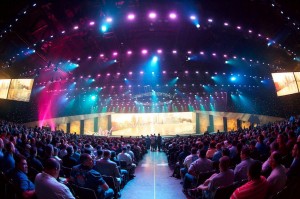Since its launch in 2010, FlexPod has been a tremendous success with more than 2,400 customers in 35 countries globally. This success has created new opportunities. Customers are requesting additional solutions based on the FlexPod platform to address an even broader spectrum of deployment types, workloads, and applications. Smaller and midsize IT departments need solutions that are fast and easy to deploy. Enterprise data centers want scale and advanced features. There is also demand for infrastructure solutions that are highly tuned to specific workloads.
Today Cisco and NetApp have extended the value of FlexPod by broadening the portfolio with new offerings, products, and validated designs. FlexPod Select joins the FlexPod portfolio which currently includes FlexPod Express (formerly ExpressPod) for medium sized businesses and FlexPod Datacenter (Formerly FlexPod) for core enterprise data centers and service providers.
FlexPod Select is targeted at performance- and data-intensive workloads such as Big Data, analytics, and high-performance computing.
I urge you to watch the video below between Keith Barto, Sr. Architect at Cisco and NetApp’s Vaughn Stewart, Director of Technical Marketing, summarizing the recent FlexPod announcements.
https://www.youtube.com/watch?v=9sAdjPJfbpc&feature=youtu.be
FlexPod Select features high-performance NetApp E-Series storage, Cisco UCS C-Series servers, Cisco Nexus Switches, and Cisco management software. FlexPod Select is the first solution in the family to feature NetApp E-Series, delivering outstanding bandwidth performance, extreme density, and modular flexibility for a wide-range of data-intensive workloads.
Hadoop will be the first solution based on the FlexPod Select architecture. Initially, there will be two validated configurations designed to accelerate deployment of Hadoop on the FlexPod architecture: FlexPod Select with Cloudera including Apache Hadoop and FlexPod Select with Hortonworks Data Platform. These new solutions based on Hadoop can enable organizations to simplify and reduce risk of Big Data architectures while delivering the performance to ask bigger questions of their data.
FlexPod Datacenter features Nexus 7000
Another important announcement is FlexPod Datacenter solutions now feature the Cisco Nexus 7000 Series Switches. The Cisco Nexus 7000 Series switches provide the highest levels of network availability, advanced features, and scalability. How much scalability? The Nexus 7000 is the highest-density 10 Gigabit Ethernet system in the industry, supporting up to 768 10 Gigabit Ethernet ports. It also enables end-to-end Fibre Channel over Ethernet (FCoE) delivering a unified Ethernet fabric, and provides Data Center Interconnect (DCI) capabilities for multi-data center deployments.
We are also introducing FlexPod Datacenter with SnapProtect to provide comprehensive Disk-to-Disk-to-Tape backup and recovery solution that includes specific implementation guidance for popular uses such as with VMware, NAS shares and Microsoft Exchange. Last but not least, we have updated FlexPod Datacenter with Microsoft Private Cloud to include support for Microsoft System Center and the Cisco Nexus 1000v switch, which was recently awarded Best of TechEd in the System Management and Operation category.
Through our shared vision and joint development, Cisco and NetApp will continue to enhance the FlexPod portfolio to grow and support additional workloads, operating models and the dynamic needs of applications.
For more information on Cisco and NetApp see below:
Share:


 Our goal is to build and maintain the world’s best partner ecosystem to drive our success in the mid-market, which is critical to accelerating our mutual profitable growth. To help fuel that growth, I’m pleased to announce that in FY14, the Partner Led and Global Virtual Sales teams will come together as one organization, under the leadership of John Donovan. John is an 18-year Cisco veteran with experience in leading businesses in Enterprise, Commercial and Channels. John will focus his team on continuing to innovate our global virtual approach, while scaling and accelerating our Partner Led model in FY14.
Our goal is to build and maintain the world’s best partner ecosystem to drive our success in the mid-market, which is critical to accelerating our mutual profitable growth. To help fuel that growth, I’m pleased to announce that in FY14, the Partner Led and Global Virtual Sales teams will come together as one organization, under the leadership of John Donovan. John is an 18-year Cisco veteran with experience in leading businesses in Enterprise, Commercial and Channels. John will focus his team on continuing to innovate our global virtual approach, while scaling and accelerating our Partner Led model in FY14.
CONNECT WITH US